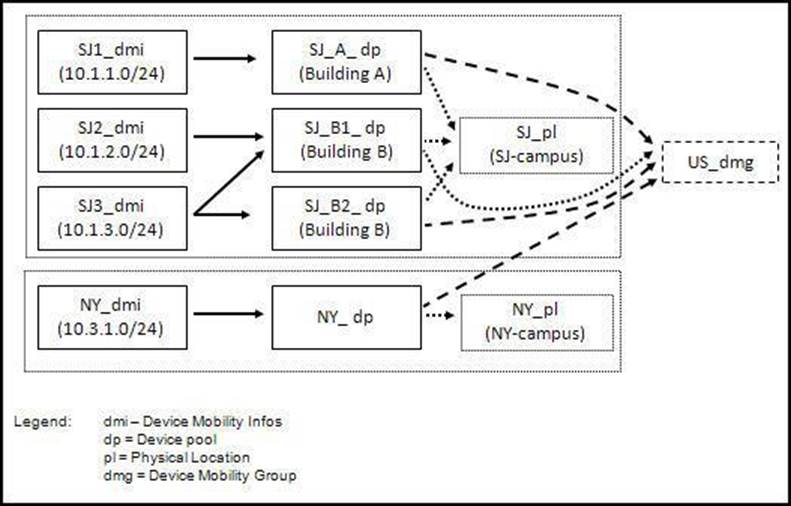Cisco 300-075 Implementing Cisco IP Telephony & Video, Part 2 v1.0 Online Training
Cisco 300-075 Online Training
The questions for 300-075 were last updated at Oct 24,2025.
- Exam Code: 300-075
- Exam Name: Implementing Cisco IP Telephony & Video, Part 2 v1.0
- Certification Provider: Cisco
- Latest update: Oct 24,2025
Which two statements about the use of the Intercluster Lookup Service in a multicluster environment are true? (Choose two.)
- A . Cisco Unified Communications Manager uses the ILS to support intercluster URI dialing.
- B . ILS contains an optional directory URI replication feature that allows the clusters in an ILS network to replicate their directory URIs to the other clusters in the ILS network.
- C . Directory URI replication does not need to be enabled individually for each cluster.
- D . To enable URI replication in a cluster, check the Exchange Directory URIs with Remote Clusters check box that appears in the SIP trunk configuration menu.
- E . If the ILS and directory URI replication feature is disabled on a cluster, this cluster still accepts ILS advertisements and directory URIs from other neighbor clusters; it just does not advertise its local directory URIs.
In Cisco Unified Communications Manager, where do you configure the +E.164 number that is advertised globally via ILS?
- A . ILS configuration under Advanced Features
- B . +E.164 alternate number under Directory Number Settings
- C . Device Information under Phone Configuration
- D . Route Pattern under Route/Hunt
When implementing a dial plan for multisite deployments, what must be present for SRST to work successfully?
- A . dial peers that address all sites in the multisite cluster
- B . translation patterns that apply to the local PSTN for each gateway
- C . incoming and outgoing COR lists
- D . configuration of the gateway as an MGCP gateway
Which code snippet is required for SAF to be initialized?
- A . Service Family
- B . External-Client
- C . router eigrp
- D . topology base
When using SAF, how do you prevent multiple nodes in a cluster from showing up in the Show Advance section of the SAF Forwarder configuration?
- A . Configure the publisher node only in the SAF Forwarder configuration page.
- B . Append an @ symbol at the end of the client label value in the SAF Forwarder configuration page.
- C . Configure the correct node in the EIGRP configuration of the gateway router that is associated with the Cisco Unified Communications Manager node.
- D . Configure the SAF Security Profile Configuration to support only a single node.
Which statement about the SAF Client Control is correct?
- A . The SAF Client Control is a configurable inherent component of Cisco Unified Communications Manager.
- B . The SAF Client Control is a non-configurable inherent component of Cisco Unified Communications Manager.
- C . The SAF Client Control is a non-configurable inherent component of the Cisco IOS Routers.
- D . The SAF Client Control is a configurable inherent component of the Cisco IOS Routers.
If you want to delete a SAF-enabled trunk from Cisco Unified Communications Manager Administration, what must you do first?
- A . Disassociate the trunk from the CCD advertising service or CCD requesting service.
- B . Delete the trunk from the CCD requesting service node.
- C . Place the Cisco Unified Communications Manager node in standby mode.
- D . Redirect CCD advertising and requesting services to another Cisco Unified Communications Manager.
Which functionality does ILS use to link all hub clusters in an ILS network?
- A . Fullmesh
- B . Automesh
- C . ILS updates
- D . multicast
Which option is known as the location attribute that the global dialplan replication uses to advertise its dial plan information?
- A . location controller
- B . route pattern
- C . route string
- D . URI
Refer to the exhibit.

If an IP phone in San Jose roams to New York, which two IP phone settings will be modified by Device Mobility so that the phone can place and receive calls in New York? (Choose two.)
- A . The physical locations are not different, so the configuration of the phone is not modified.
- B . The physical locations are different, so the roaming-sensitive parameters of the roaming device pool are applied.
- C . The device mobility groups are the same, so the Device Mobility-related settings are applied in addition
to the roaming-sensitive parameters. - D . The Device Mobility information is associated with one or more device pools other than the home device pool of the phone, so one of the associated device pools is chosen based on a round-robin load-sharing algorithm.
- E . The Device Mobility information is associated with the home device pool of the phone, so the phone is considered to be in its home location. Device Mobility will reconfigure the roaming-sensitive settings of the phone.
Latest 300-075 Dumps Valid Version with 520 Q&As
Latest And Valid Q&A | Instant Download | Once Fail, Full Refund

